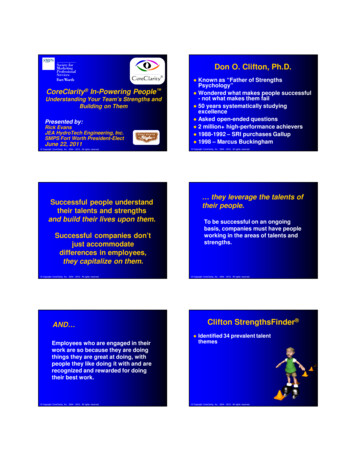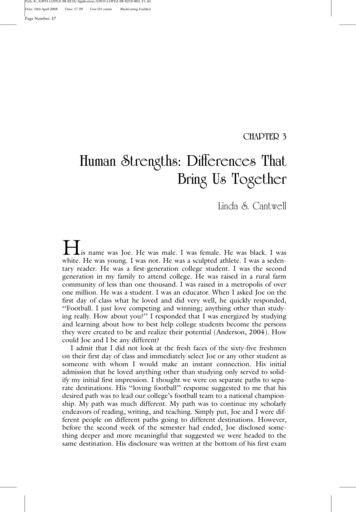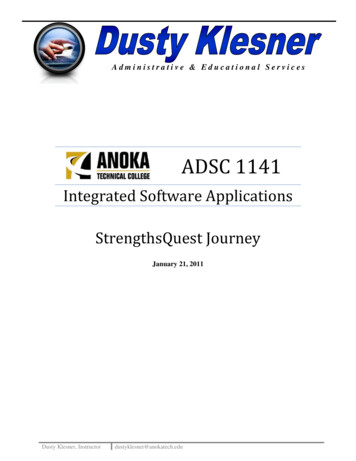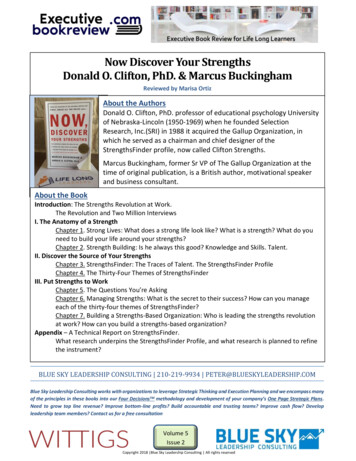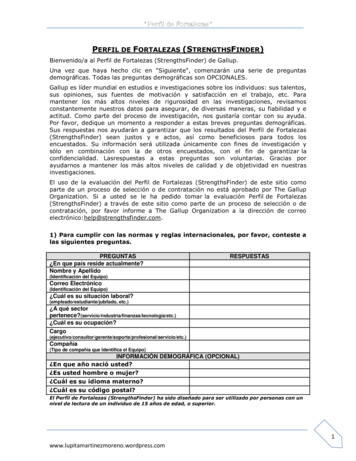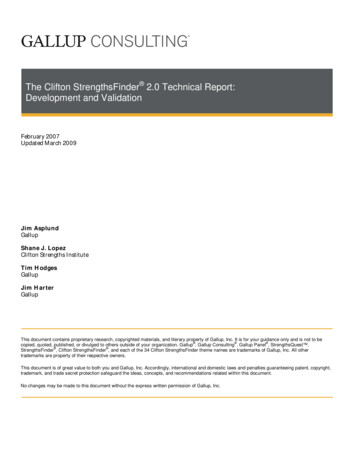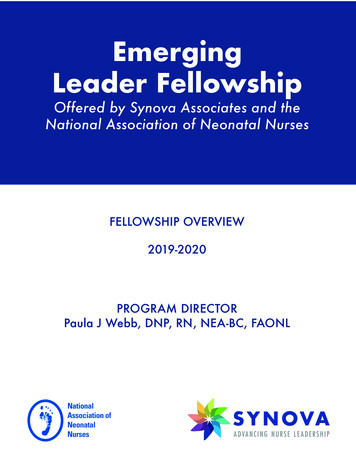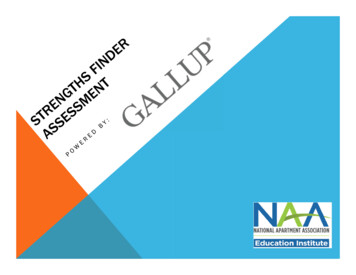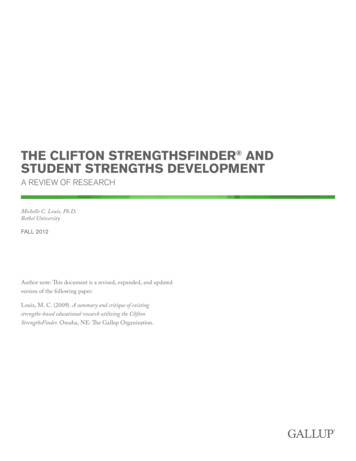
Transcription
THE CLIFTON STRENGTHSFINDER ANDSTUDENT STRENGTHS DEVELOPMENTA REVIEW OF RESEARCHMichelle C. Louis, Ph.D.Bethel UniversityFALL 2012Author note: This document is a revised, expanded, and updatedversion of the following paper:Louis, M. C. (2009). A summary and critique of existingstrengths-based educational research utilizing the CliftonStrengthsFinder. Omaha, NE: The Gallup Organization.
This document contains proprietary research, copyrighted materials, and literary propertyof Michelle C. Louis and Gallup, Inc. The Clifton StrengthsFinder theme descriptionsand assessment items are copyright 2000, Gallup, Inc. All rights reserved. Thisdocument may not be reproduced without the written permission of Michelle C. Louis andGallup, Inc.Gallup , StrengthsQuest , StrengthsFinder , Clifton StrengthsFinder , and each of the 34Clifton StrengthsFinder theme names are trademarks of Gallup, Inc. All other trademarksare the property of their respective owners.
Strengths RulesShane J. Lopez, Ph.D.Research Director, The Clifton Strengths InstituteSenior Scientist in Residence, Gallup“What would happen if we actually study what is right with people?” There is a short answer to this question posedby Dr. Donald Clifton, a pioneer in the field of strengths psychology and creator of the Clifton StrengthsFinder. Inthe last 50 years, Gallup has learned that people and organizations grow more when they focus on what they do bestrather than trying to fix their weaknesses.Doing what you do best is not always easy. Based on Gallup’s research in North America, Europe, and Asia, onlyabout half of the people studied take a strengths approach to school, work, and life. So, it can be hard for a studentor employee to put the strengths approach into practice if every other person he or she meets believes that fixingweaknesses is the primary path to success.The change agents who adhere to the strengths approach have worked hard to create exercises, training modules, andclasses that encourage people to do what they do best. Some of these activities are brilliantly designed and executed.Others are not. Most have not been evaluated for their effectiveness.Which strengths development programs are effective and why? That is a question we have to answer if we are tooptimize the efforts of educators, managers, and leaders. This review of the literature conducted by Dr. MichelleLouis of Bethel University is a summary of what we know about strengths development and a guide to what we needto do next.Based on my review of this paper, I have constructed a set of “strengths rules” that I encourage everyone to followwhen they are designing new activities to help people do what they do best. These rules are empirically derived andbased on key findings of strengths researchers from around the world: Knowing your strengths is not enough. Completing the StrengthsFinder is just a starting point. Strengths development is aimed at a personally salient goal. Strengths come to life as they help you to answerlife’s “now what” questions. Development takes tremendous effort. You must apply your strengths in daily life. Strengths grow in the context of relationships, teams, and organizations.With these rules in mind, I believe we can design more effective strengths development programs. We will onlyknow for sure if we become more systematic in evaluating our efforts. Here are tips for determining what works: Specify the goals of the strengths development program. Base the program on the strengths rules and execute the program as designed. Administer validated measures before and after the program to track change. If possible, compare strengths development with some other program to determine added value.With a coordinated effort, strengths practitioners and researchers can determine which programs work and whyby 2020. With a more sophisticated understanding of strengths development, we will be able to accelerate our owngrowth and that of our families and community members, students, and employees.
THE CLIFTON STRENGTHSFINDER AND STUDENT STRENGTHS DEVELOPMENTTHE CLIFTON STRENGTHSFINDER ANDSTUDENT STRENGTHS DEVELOPMENTA REVIEW OF RESEARCHGreitemeyer, 2003), as a strengths perspective can produce“the ability to flexibly apply as many different resources andskills as are necessary to solve a problem or work towarda goal” (Aspinwall & Staudinger, 2003, p. 13) by helpingpeople consider the personal resources they can mobilize toachieve favorable ends.INTRODUCTIONThe integration of a strengths perspective intoincreasingly diverse types of educational environmentsand practices demands concomitant research that exploresthe effectiveness of these efforts and informs futurepractice. An overview of the development of the CliftonStrengthsFinder is presented, followed by a comprehensivereview of research that explores the nature and impact ofefforts to promote student strengths development withinsecondary and postsecondary education. This reviewconcludes with a series of suggestions for future research onstrengths-based initiatives.At the individual level, a strengths approach encompassesthe identification of positive personal and interpersonalcharacteristics, along with their integration into one’s viewof self, resulting in behavioral changes (Clifton & Harter,2003). A strengths-based approach also informs currentscholarship on organizational behavior by promoting thescientific community’s attentiveness to the positive dynamicsand productive practices that exist at the communal ororganizational level (Cameron, Dutton, & Quinn, 2003).Regardless of whether the strengths perspective is used togenerate understanding and inform practice at the macroor micro level, its central aim is to pinpoint and amplifythe promising characteristics of individuals, families, andcommunities (Saleebey, 2006). All applications of thestrengths approach are founded upon the assertion that“human strengths are not secondary, derivative, illusory,epiphenomenal, parasitic upon the negative, or otherwiseTHE STRENGTHS PERSPECTIVEA strengths perspective is characterized by “efforts tolabel what is right” within people and organizations(Buckingham, 2007, p. 6) and assumes that every individualhas personal qualities that can be mobilized towarddesirable outcomes in many areas of life (Anderson, 2000;Saleebey, 2001). The strengths approach explores ways toempower individuals toward thriving rather than meresurvival (Liesveld & Miller, 2005) and assumes thatcapitalizing on one’s areas of talent is likely to lead to greatersuccess than would be possible by making a comparableinvestment of effort into overcoming personal weaknessesor deficiencies (Clifton & Harter, 2003). This paradigmtherefore highlights the importance of intentionallychoosing to focus one’s attention and energy into cultivatingthat which will yield the most significant growth (Shushok& Hulme, 2006), which is accomplished not by ignoringweaknesses, but by instead seeking to understand andmanage areas of deficiency while optimizing effort bybuilding on strengths (Clifton & Harter, 2003; Clifton &Nelson, 1992). Strengths-based ideology provides insight forthe design of intervention programs that prompt individualstoward achieving positive goals and aims (Frey, Jonas, &suspect” (Peterson & Seligman, 2004, p. 4) but that thestudy of strengths is legitimate in its own right as a way ofcultivating wellbeing.VARIOUS CONCEPTUALIZATIONSOF HUMAN STRENGTHOne approach to understanding strengths views them astalents that have been developed to produce consistent levelsof excellent performance in a particular activity (Clifton &Anderson, 2002), and the work of researchers at Gallup isfounded upon this particular definition of the terminologyassociated with the study of human strengths. Althoughresearchers and practitioners adopting other understandingsCopyright . All rights reserved.2
THE CLIFTON STRENGTHSFINDER AND STUDENT STRENGTHS DEVELOPMENTof strengths have contributed in many valuable waysto contemporary research and practice, this review isfocused on a description of the Gallup model of strengthsand the research and applications that are derived fromit specifically.THE DEVELOPMENT AND INTENT OFTHE CLIFTON STRENGTHSFINDER Four decades ago, Gallup researchers began a projectfocused on an empirical discovery of the components ofhuman strength. Educational psychologist Don Cliftonchampioned this effort, beginning with a series of projectsinspired by the question, “What would happen if westudied what is right with people?” (Lopez, Hodges, &Harter, 2005, p. 3). Clifton held the unwavering convictionthat human strength and excellence could be empiricallyinvestigated in a rigorous, widespread manner. He and hiscolleagues thereby developed semi-structured interviewprotocols designed to pinpoint the persistent thoughts,feelings, and behaviors associated with situational successin a variety of fields. Gallup subsequently conducted theseinterviews with more than two million individuals for thepurposes of employee selection and personal development(Asplund, Lopez, Hodges, & Harter, 2009).Gallup defines talents as “naturally recurring patternsof thought, feeling, or behavior that can be productivelyapplied” (Hodges & Clifton, 2004, p. 257), includingan individual’s patterns or tendencies when interactingwith others, processing information, or navigating anenvironment. Because these talents are viewed as trait-likeand naturally occurring, individuals often use them withoutconscious awareness of their presence (Clifton, Anderson, &Schreiner, 2006; Drucker, 2000). Clusters of similar talentsare grouped into talent themes. An individual’s five mostdominant talent themes are referred to within this modelas Signature Themes (Clifton & Anderson, 2002). SignatureThemes can be developed through the addition of acquiredknowledge and skill to form a strength, which is defined asthe ability to produce “consistent, near-perfect performancein a given activity” (Clifton & Anderson, 2002, p. 8).Strengths are therefore not listed comprehensively becausethey are specific to a particular activity or context and canbe understood as specific, energizing activities one performswith excellence (Buckingham, 2007).Clifton and his colleagues systematically reviewed thedata generated by the interviews to reveal the anatomy ofmore than 400 types of talent, creating an initial pool ofmore than 5,000 items that were candidates for inclusionin a comprehensive measure of positive human qualities(Asplund et al., 2009). This information was subjectedto extensive reliability and validity analyses; those itemswith the strongest psychometric properties were retained,providing the foundation for the 1999 launch of theearliest version of an instrument called the StrengthsFinder.This instrument’s first edition contained 180 item-pairsdesigned to assess a respondent’s top areas of talent from aset of 34 possible themes; this online instrument was thefirst to provide an omnibus assessment of human talent(Lopez, 2007). It was renamed the Clifton StrengthsFinderfollowing Clifton’s death in 2003 (Lopez et al., 2005),and in 2006, researchers began a systematic review of itspsychometric properties. Analysts recommended changesfor psychometric improvements to theme reliabilitiesand validities; these adjustments were related to howexisting items were scored as well as modifications thatrequired either adding or removing specific items (Asplundet al., 2009).Clifton and Nelson (1992) propose that there are fourindicators of the presence of strengths. Specifically, theseauthors note that individuals are intuitively drawn toactivities that will facilitate strengths utilization, andso they advocate for people to cultivate an awareness ofthese types of “yearnings” (p. 43). A second signal that astrength may be at use is when an individual derives greatsatisfaction and energy from investment in an activity,experiencing a sense of engagement and timelessness calledflow (Csikszentmihalyi, 1990). Rapid learning is anothersign of a strength’s presence, and the fourth indicatorof a strength in action is that “glimpses of excellence”(Clifton & Anderson, 2002, p. 52) are demonstrated whenan individual attempts an activity that requires the useof a particular strength (Buckingham, 2007; Clifton &Anderson, 2002).Copyright . All rights reserved.3
THE CLIFTON STRENGTHSFINDER AND STUDENT STRENGTHS DEVELOPMENTThe revised iteration of the Clifton StrengthsFinder contains177 items, which is a three-item reduction from the previousversion. The initial version of the instrument offeredrespondents a short description of their top five clustersof talent (Signature Themes), as well as suggestions forcapitalizing on each, whereas the feedback for the updatedversion is more detailed and customized in that it is basedon both theme-level and item-level data to form a morenuanced description of the respondent’s unique pattern ofresponses (Asplund et al., 2009). Currently available inmore than 20 languages, the instrument has been completedby more than eight million people worldwide (Gallup, 2012)and can be modified for individuals with disabilities toallow for greater accessibility. The Clifton StrengthsFinder isnot designed to measure psychological illness or wellness,but exists to serve as a tool for personal development (Lopezet al., 2005). A common misconception is that the CliftonStrengthsFinder highlights an individual’s strengths, butthe developers of this instrument actually assert that it isintended to instead identify areas of inherent talent thatcan be deliberately developed into personal strengths.Related supporting materials pertinent for a variety ofsettings are also available, and these resources are designedto offer strategies for developing Signature Theme talentsinto strengths within the spheres of leadership, business,education, and ministry (Buckingham & Clifton, 2001;Clifton et al., 2006; Liesveld & Miller, 2005; Rath &Clifton, 2004; Rath & Conchie, 2009; Winseman, Clifton,& Liesveld, 2004). Of particular relevance to this reviewis the existence of StrengthsQuest (Clifton, Anderson, &Schreiner, 2006), which is a text containing additionalinformation about the nature and application of CliftonStrengthsFinder results, tailored for students and educators.prominence within recent years. A strengths-basededucational approach is a departure from many of thedeficit-based models that prevail in many contemporarycircles of practice (Anderson, Cave, & McDowell, 2001). Itrepresents a return to educational principles that emphasizethe positive aspects of student effort and elevate studentstrengths (Lopez & Louis, 2009). A strengths-basededucation has been defined as one that “involves a processof assessing, teaching, and designing experiential learningactivities to help students identify, develop, and apply theirstrengths and talents” (Anderson, 2004, p. 1). Accordingto Lopez and Louis (2009), this approach includes severalcomponents: (a) measurement of strengths, achievement, anddeterminants of positive outcomes; (b) individualization,which is a personalized educational approach that considersstudents’ goals, needs, and interests; (c) networking withothers who can encourage strengths use and provide usefulfeedback; (d) deliberate application of strengths within andbeyond the classroom; and (e) intentional development ofstrengths. The objective of strengths-based education isto aid students in applying their talents in the learningprocess to enable them to reach previously unattained levelsof personal excellence (Anderson, 2004), thereby helpingstudents become confident, efficacious, life-long learnerswhose lives are instilled with a sense of purpose (Anderson,2000). Engaging students in a strengths developmentprocess can catalyze thriving and help students derivemaximum benefit from the college experience (Louis &Schreiner, 2012).Some contemporary writers use the term talent developmentto denote a concept that essentially embodies the strengthsapproach to promoting student success in that it “arrangesresources and learning conditions to maximize studentpotential” (Kuh, Kinzie, Schuh, Whitt, & Associates, 2005,p. 77). Talent development practices are founded upon theconviction that all students are capable of learning if theeducational environment adequately supports this objectiveby adjusting institutional policies and pedagogical practicesSTRENGTHS DEVELOPMENT WITHINEDUCATIONAL SETTINGSThe underlying principles of the strengths approach havefound resonance in several fields, including social work(Saleebey, 1997), organizational theory and behavior(Luthans, Youssef, & Avolio, 2007), and education(Anderson, 2004; Mather, 2010). Within the domain ofeducation, strengths-based models have gained increasedto help students realize their potential. Following extensiveresearch on the elements of effective educational practice,one source advocates strongly for talent developmentto become a central tenet in postsecondary institutions’Copyright . All rights reserved.4
THE CLIFTON STRENGTHSFINDER AND STUDENT STRENGTHS DEVELOPMENToperating philosophies because “student success starts withan institutional mission that espouses the importance oftalent development and then enacts this vision” (Kuh et al.,2005, p. 266). Institutions that embrace a comprehensivestrengths-based approach conduct research to understandsuccessful students on campus, create a campus culturethat facilitates students’ discovery of personal talentsand strengths, and aid students in the process of findingpractical avenues for the expression of their strengths(Shushok & Hulme, 2006).STRENGTHS INTERVENTIONRESEARCH IN K-12 EDUCATIONAlthough there are no published studies that examinethe use of strengths-based educational approaches withstudents in primary school settings, several such studieshave been completed with high school student populations.Each of these investigations was conducted with studentsduring their first year of high school, involved the use of theClifton StrengthsFinder and the associated StrengthsQuesttext (Clifton & Anderson, 2002) as a basis for the strengthscurriculum, and utilized self-report measures to assess thedependent variables under investigation. The followingsection outlines the methodology and findings of each ofthese research endeavors and notes the contributions andlimitations of these studies.RESEARCH ON STRENGTHS-BASEDEDUCATIONAL APPROACHESEducational strategies that embody a strengths perspectiveare now being used in K-12 education (Austin, 2005;Gillum, 2005; Purnell School, 2007) as well as in collegesand universities across the country (Shushok & Hulme,2006). At the postsecondary level, strengths-basedapproaches have been introduced into first-year studentprograms (Cave, 2003; Louis, 2011; Schreiner, 2004a;Stebleton, Soria, & Albecker, 2012; Tomasiewicz, 2011),subject-specific course curriculum (Cantwell, 2005;Passarelli, Hall, & Anderson, 2010), athletics (Robles,2012), academic advising (Schreiner & Anderson, 2005;Swanson, 2006), student orientation and leadershipdevelopment programs (Lehnert, 2009; Pritchard, 2009;Tanious, 2012), and other campus-based efforts to promoteoptimal functioning in college students (Louis & Schreiner,2012; Schreiner, Hulme, Hetzel, & Lopez, 2007). Thefollowing section offers an account of the findings ofexisting research studies designed to assess the impact ofthe use of the Clifton StrengthsFinder and related strengthsbased interventions within the field of education. It alsodescribes emerging research that offers insight into therelationships that exist between the talent themes measuredby the Clifton StrengthsFinder and other variables of interestwithin educational settings. The description of each researchinvestigation includes information about the researchResearch conducted by Gillum (2005) sought to determinewhether teaching high school students who scored in thebottom quartile on measures of mathematics performanceindicators about their strengths might have a positive effecton these students’ subsequent quality of effort in theirmathematics courses and their intentional use of personalstrengths. Gillum used a mixed-methods strategy thatemployed a quasi-experimental, pretest-posttest design witha control group, paired with a phenomenological approachto understand the experience of students who participatedin the study.The participants in Gillum’s (2005) study (n 103) wereenrolled in their first year of high school and had beenassigned to four separate math classes based on theirunderperformance on statewide standardized mathematicstests. Gillum randomly designated each class to receivedifferent types of strengths treatments. The first class ofstudents (n 31) was exposed to the Clifton StrengthsFinderand six 55-minute class sessions that provided instructionon how to apply their strengths. The second class (n 25) completed the Clifton StrengthsFinder but received nosupplemental instruction. The third group (n 21) was notexposed to the Clifton StrengthsFinder, but the studentsin this group were instead given descriptions of eachof the talent themes measured by this inventory. Thesestudents were asked to identify the five talent themes thatdesign, methodology, participant sample, instrumentation,and central findings. Comments related to the appropriateinterpretation of each study’s results and noteworthylimitations are also provided.Copyright . All rights reserved.5
THE CLIFTON STRENGTHSFINDER AND STUDENT STRENGTHS DEVELOPMENTthey believed were most personally descriptive prior toreceiving six 55-minute class sessions about how to utilizethese talents. The fourth class (n 26) served as a controlgroup and therefore was exposed to neither the CliftonStrengthsFinder nor the associated instruction. Prior to theinterventions, all of the student participants were asked tocomplete pretest inventories that assessed quality of effort,knowledge of personal strengths, and use of strengths. Theteachers of each of the four mathematics classes were alsoasked to complete Likert-type pretest questionnaires thatprompted them to assess each student’s quality of effort,attendance, and homework completion. These measureswere repeated after the intervention phase of the studywas complete.However, Gillum’s study does provide preliminary evidencethat effort increases in samples of underperforming highschool students when these students are offered guidancerelated to how to utilize their strengths.Austin (2005) conducted a controlled experimental studywithin the context of ninth-grade health education coursesat a large suburban high school designed to assess theimpact of a strengths intervention on several dependentvariables. Specifically, the independent variable in this studywas the curriculum type (strengths-based vs. traditionalhealth education course curriculum), and the dependentvariables included academic expectancy, academic intrinsicmotivation, academic extrinsic motivation, academicefficacy, and academic achievement. Those students(n 255) randomly assigned to the experimental groupparticipated in a six-week strengths intervention thatutilized the StrengthsQuest Curriculum Guide and LearningActivities (Anderson, 2003), while those in the controlgroup (n 255) spent an equivalent amount of time learningtraditional health education curriculum. At the end ofthe six-week period, students were asked to complete anassessment that the researcher developed and validatedfor the purposes of his study (Indicators of AcademicAchievement Questionnaire, Austin, 2004). Following thissix-week time period and the completion of the assessment,the two groups rotated to ensure that all students wereexposed to equivalent curriculum, regardless of treatmentcondition. Austin reported that students initially exposedto the strengths curriculum demonstrated higher academicintrinsic motivation and more positive academic risk-takingbehaviors at levels of statistical significance. There were nosignificant differences between the two groups on academicexpectancy and efficacy, academic extrinsic motivation, orachievement scores in mathematics and English.To complete the qualitative portion of the study, apurposeful sample of five students from the treatment groupthat received both the Clifton StrengthsFinder assessmentand the supplemental strengths training was selected forparticipation in semi-structured interviews. These individualinterviews were conducted by the researcher immediatelyfollowing the completion of the strengths training andagain one month later to gain information about thestudents’ attitudes about their strengths and whether theybelieved that their knowledge about their personal strengthswould prompt them to improve their effort.Gillum reported that the most favorable results occurredin the groups that received specific instruction on howto utilize their strengths, as students in these conditionsexpressed an increased desire to apply their strengths withinand outside the classroom. They also increased the qualityof their effort in their mathematics classes (Gillum, 2005).Several limitations are relevant for this particular study,including possible interference from extraneous variablesdue to lack of random assignment and imbalanced supportof the study by participating mathematics instructors. Inaddition, the researcher only asked about the experienceof students in one of the treatment conditions. It may haveThere are several noteworthy limitations to Austin’s (2005)study. Although the random assignment of students tocondition should eliminate concerns about pre-interventionadded value to the study had he also inquired about theexperiences of students in the other three conditions as well.The small sample sizes generated marginal results, and thegeneralizability of the findings of this research is limited.differences between the groups, Austin was not able todemonstrate the lack of differential selection conclusivelybecause only posttest data were collected. In addition, theresearcher could not control for the diffusion of treatment;Copyright . All rights reserved.6
THE CLIFTON STRENGTHSFINDER AND STUDENT STRENGTHS DEVELOPMENTit is plausible that students in the control condition receivedinformation about the content of the experimental conditionfrom their classmates. Finally, Austin introduced anextraneous variable by choosing specific teachers to conductthe experimental class sessions who had “positive rapportwith students” (p. 39) and who were “selected due to theircaring nature and ability to facilitate discussions” (p. 39),whereas the teachers leading the classes in the controlcondition were “not necessarily selected for their personalattributes” (p. 39), but were instead chosen based upontheir credentials to teach the content of the course. Teacherstyle may have significantly influenced the outcome of thestudy, as the observed differences between groups could beaccounted for by this factor alone. In addition, because boththe treatment and control groups were ultimately exposed tostrengths training, Austin was limited in his ability to assessdifferences between the groups longitudinally, which wouldhave provided insight into the durability of any observedintervention effects.class than were their counterparts in the control group.Turner’s inability to randomly assign students to conditionsin this study represents a significant limitation of thisresearch. In addition, one possible confound to the findingsis that students in the control condition experienced adifferent kind of pedagogical approach than did thosein the experimental group (traditional instruction withindependent work versus small-group interaction).Turner’s research closely mirrors a study performed byresearchers at Gallup several years prior (Harter, 1998, ascited in Clifton & Harter, 2003). The Gallup study involvedstudents (n 1,648) at an urban high school and utilizeda time series design over a four-year period to determinewhether students who had been given personal feedbackon their talents as identified by the Clifton StrengthsFinderwould demonstrate differences in GPA, tardiness, andabsenteeism when compared with a control group who hadnot received information about their talents. In each year ofthis study, a group of randomly selected teachers receivedtraining from Gallup related to how to conduct a specifictalent identification interview process. Following training,these teachers then provided individual and large-groupfeedback to ninth-grade students in the experimentalcondition (n 807) about how to use their talents.Students in the control condition (n 841) did not receivethe individual consultation or the large group feedback.Students’ grades, tardiness, and absenteeism were measuredat the end of the semester, and students in the treatmentgroup were found to have a significantly lower incidence oftardiness and absenteeism and higher GPAs than studentsin the control group.The final study that evaluated the effect of using astrengths-based approach with high school studentsadopted a quasi-experimental pretest-posttest nonequivalentcontrol group design and assessed first-year high schoolstudents’ grade point averages, their frequency of beinglate to class, and their involvement in behaviors whichrequired disciplinary responses (Turner, 2004). Students inthe experimental condition (n 76) completed the CliftonStrengthsFinder and participated in two semesters of weekly45-minute class sessions focused on using the StrengthsQuestCurriculum Guide and Learning Activities (Anderson, 2003)and the StrengthsQuest text (Clifton & Anderson, 2002).During these sessions, students participated in strengthsbased learning activities in small groups of three to fourindividuals. Students in the control condition receivedtraining and instruction in computer word processingduring the same time period. T
StrengthsFinder is presented, followed by a comprehensive review of research that explores the nature and impact of efforts to promote student strengths development within secondary and postsecondary education. This review conc
